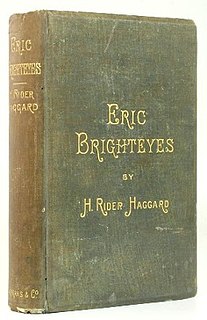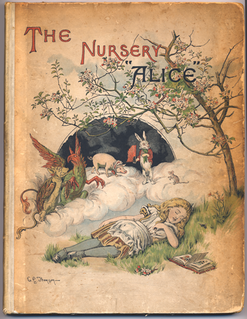 W
WThe Bondman is an 1890 best-selling novel by Hall Caine set in the Isle of Man and Iceland. It was the first novel to be released by the newly established Heinemann publishing company. It was a phenomenal success and was later adapted into a successful play and two silent films.
 W
WA Bride from the Bush is the first novel written by E. W. Hornung. He started writing the book while working as a tutor for Charles Joseph Parsons in Mossgiel Station, New South Wales, Australia. The novel was initially published by Smith, Elder & Co. as a serial in the Cornhill Magazine, and then published in book format by the same company in October 1890. As with Tiny Luttrell and The Unbidden Guest, two of Hornung's other early novels, A Bride from the Bush points out flaws in British society by presenting the country through an Australian perspective. A reviewer from The New York Times called the novel "a most piquant contrast between civilization and crudity". The writer Thomas Alexander Browne called the titular character of A Bride from the Bush "a libel to Australian womankind". A Punch editor made the opposite claim, arguing that the protagonist of the novel is more kind-hearted and attractive than actual Australians.
 W
WThe Saga of Eric Brighteyes is an epic viking novel by H. Rider Haggard that concerns the adventures of its eponymous principal character in 10th-century Iceland. The novel was first published in 1890 by Longmans, Green & Company. It was illustrated by Lancelot Speed.
 W
WThe Firm of Girdlestone is a novel by British author Sir Arthur Conan Doyle. It was first published in 1890 by Chatto and Windus in London, England. In 1915 a silent film adaptation The Firm of Girdlestone was made.
 W
WKit and Kitty: a story of west Middlesex is a three-volume novel by R. D. Blackmore published in 1890. It is set near Sunbury-on-Thames in Middlesex.
 W
WNews from Nowhere (1890) is a classic work combining utopian socialism and soft science fiction written by the artist, designer and socialist pioneer William Morris. It was first published in serial form in the Commonweal journal beginning on 11 January 1890. In the novel, the narrator, William Guest, falls asleep after returning from a meeting of the Socialist League and awakes to find himself in a future society based on common ownership and democratic control of the means of production. In this society there is no private property, no big cities, no authority, no monetary system, no divorce, no courts, no prisons, and no class systems. This agrarian society functions simply because the people find pleasure in nature, and therefore they find pleasure in their work.
 W
WThe Nursery "Alice" (1889/90) is a shortened version of Alice's Adventures in Wonderland (1865) by Lewis Carroll, adapted by the author himself for children "from nought to five". It includes 20 of John Tenniel's illustrations from the original book, redrawn, enlarged, coloured – and, in some cases, revised – by Tenniel himself. The book was published by Macmillan a quarter-century after the original Alice. It featured new illustrated front and back covers in full colour by E. Gertrude Thomson, who was a good friend of Dodgson. The book was 'engraved and printed' by the famous colour printer Edmund Evans.
 W
WThe Picture of Dorian Gray is a Gothic and philosophical novel by Oscar Wilde, first published complete in the July 1890 issue of Lippincott's Monthly Magazine. Fearing the story was indecent, prior to publication the magazine's editor deleted roughly five hundred words without Wilde's knowledge. Despite that censorship, The Picture of Dorian Gray offended the moral sensibilities of British book reviewers, some of whom said that Oscar Wilde merited prosecution for violating the laws guarding public morality. In response, Wilde aggressively defended his novel and art in correspondence with the British press, although he personally made excisions of some of the most controversial material when revising and lengthening the story for book publication the following year.
 W
WThe Sign of the Four (1890), also called The Sign of Four, is the second novel featuring Sherlock Holmes written by Sir Arthur Conan Doyle. Doyle wrote four novels and 56 short stories featuring the fictional detective.
 W
WThe Snake's Pass is an 1890 novel by Bram Stoker. It centers on the legend of Saint Patrick defeating the King of the Snakes in Ireland. The novel also centers on the troubled romance between the main character and a local peasant girl. The Snake's Pass was Bram Stoker's second imperial fiction novel, and was first published in the United Kingdom in 1890. The novel is a precursor to Stoker's Dracula but was his only novel written in his native land of Ireland.
 W
WThe Tragic Muse is a novel by Henry James, first published as a serial in The Atlantic Monthly in 1889-1890 and then as a book in 1890. This wide, cheerful panorama of English life follows the fortunes of two would-be artists: Nick Dormer, who throws over a political career in his efforts to become a painter, and Miriam Rooth, an actress striving for artistic and commercial success. A cast of supporting characters help and hinder their pursuits.
 W
WWith Lee in Virginia, A Story of the American Civil War (1890) is a book by British author G.A. Henty. It was published by Blackie and Son Ltd, London. Henty's character, Vincent Wingfield, fights for the Confederate States of America, even though he is against slavery. As suggested by the title, he is primarily with the Army of Northern Virginia. Henty's novel has been cited by some literary historians as an example of British right-wingers' sympathy for the Confederate cause; discussing With Lee in Virginia, Jeffrey Richards cites the book as "significantly pro-Southern". Henty defends slavery throughout the novel, stating although slavery was capable of "abominable" cruelty under brutal masters, "..taken all in all, the negroes on a well-ordered estate, under kind masters, were probably a happier class of people than the laborers upon any estate in Europe." At the novel's end, Henty has the Wingfield family's former slaves return and continue working for their former owners:The negroes, however, for the most part remained steadily working on the estate. A few wandered away, but their places were easily filled; for the majority of the freed slaves very soon discovered that their lot was a far harder one than it had been before, and that freedom so suddenly given was a curse rather than a blessing to them.
 W
WThe World's Desire is a fantasy novel first published in 1890 and written by H. Rider Haggard and Andrew Lang. It was published in paperback by Ballantine Books as the fortieth volume of the Ballantine Adult Fantasy series in January 1972.